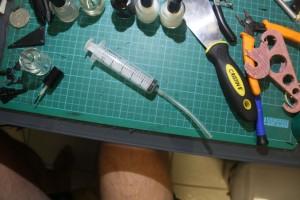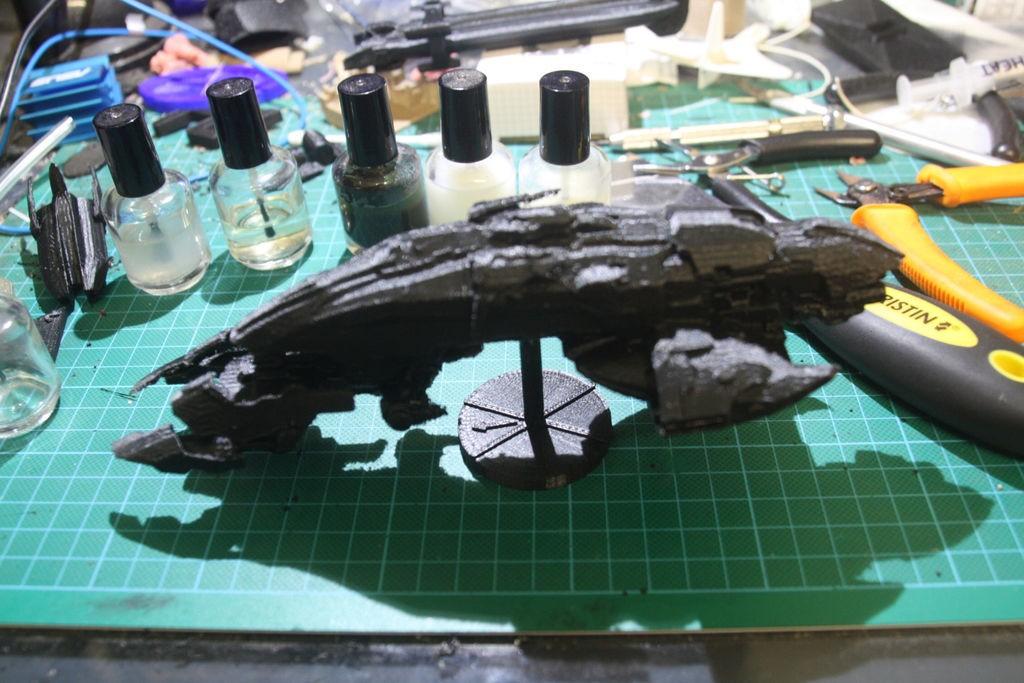 Rob, who goes by “northernmenace” on both Instructables and Thingiverse, wants to help you make “the most useful accessory to 3D printing, the Glue.”
Rob, who goes by “northernmenace” on both Instructables and Thingiverse, wants to help you make “the most useful accessory to 3D printing, the Glue.”
To make it happen, Rob says you’ll need some nail polish bottles–he got his online from an Australian beauty salon supplies store–some acetone you can pick up at the hardware store, and some leftover scrap plastic from previous 3D printing projects. Having a syringe and a length of fish tank air line hose comes in handy as well.
He says you can use the home made glue to join, color, and strengthen your printed objects.
It’s a fairly easy project, but it will prove critical to your finishing tasks. It goes like this: pour some of the acetone into a nail polish bottle until it’s about two-thirds full, add bits of scrap plastic of a single color until the bottle is full, and then screw the lid on and wait overnight for the plastic to melt.
According to Rob, you can add more of the leftover plastics to control the thickness of the mixture to fit your requirements.
To use the mix for gluing, you paint the acetone or acetone mix onto both sides of a pair of parts you want to join, press the parts together for about ten seconds and voilà, a full strength bond is complete in about an hour.
To smooth a part, use either the plain acetone or a mixture which contains colored plastic to match the filament you used to build your part. Simply brush it on slowly to create the desired effect.
Rob says you can also color a printed object by using a dark colored formulation of the solution on a light object to achieve a “mottled color” effect by dabbing the solution on a bit at a time and letting it dry a little, repeating the process until the strength of the color meets your needs.
If you need to strengthen thin areas of a printed part, Rob adds that you can paint layers of the colored mixture on to build them up. He used this technique to strengthen one of his models, the Colonial One ship.
“The fins were way too thin and really flexible, a coat of black acetone mix has made them strong enough for the whole model to stand on upright,” northernmenace reports.
Keep in mind that this technique only works with ABS material as PLA is not soluble in acetone.
Acrylonitrile butadiene styrene – or ABS – is a common thermoplastic polymer made by polymerizing styrene and acrylonitrile in the presence of polybutadiene. A common formulation will likely contain 15 to 35% acrylonitrile, 5 to 30% butadiene and 40 to 60% styrene. The resulting material is a long chain of polybutadiene criss-crossed with shorter chains of styrene-co-acrylonitril.
If you find that your “ABS” won’t dissolve in acetone, you may have a batch of impure material on your hands.
Have you ever used a technique like this to finish or strengthen your 3D printed objects? Do you have an alternative technique you use? Let us know in the 3D Printing Glue forum thread on 3DPB.com.
Subscribe to Our Email Newsletter
Stay up-to-date on all the latest news from the 3D printing industry and receive information and offers from third party vendors.
You May Also Like
Gorilla Sports GE’s First 3D Printed Titanium Cast
How do you help a gorilla with a broken arm? Sounds like the start of a bad joke a zookeeper might tell, but it’s an actual dilemma recently faced by...
Nylon 3D Printed Parts Made More Functional with Coatings & Colors
Parts 3D printed from polyamide (PA, Nylon) 12 using powder bed fusion (PBF) are a mainstay in the additive manufacturing (AM) industry. While post-finishing processes have improved the porosity of...
$25M to Back Sintavia’s Largest Expansion of Metal 3D Printing Capacity Since 2019
Sintavia, the digital manufacturing company specializing in mission-critical parts for strategic sectors, announced a $25 million investment to increase its production capacity, the largest expansion to its operations since 2019....
Velo3D Initiates Public Offering in a Bid to Strengthen Financial Foundations and Drive Future Growth
Velo3D (NYSE: VLD) has been among a number of publicly traded 3D printing firms that have attempted to weather the current macroeconomic climate. After posting a challenging financial report for 2023,...































